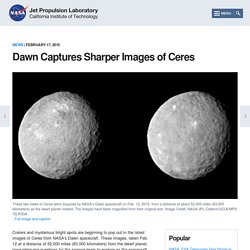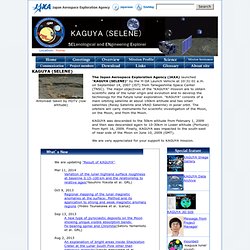

Kepler Space Telescope. James Webb Space Telescope (JWST) NASA. Solar Dynamics Observatory. Dawn Captures Sharper Images of Ceres. Craters and mysterious bright spots are beginning to pop out in the latest images of Ceres from NASA's Dawn spacecraft.

These images, taken Feb. 12 at a distance of 52,000 miles (83,000 kilometers) from the dwarf planet, pose intriguing questions for the science team to explore as the spacecraft nears its destination. The image is available at: "As we slowly approach the stage, our eyes transfixed on Ceres and her planetary dance, we find she has beguiled us but left us none the wiser," said Chris Russell, principal investigator of the Dawn mission, based at UCLA.
"We expected to be surprised; we did not expect to be this puzzled. " Dawn will be gently captured into orbit around Ceres on March 6. The spacecraft explored the giant asteroid Vesta for 14 months during 2011 and 2012. Dawn's mission to Vesta and Ceres is managed by the Jet Propulsion Laboratory for NASA's Science Mission Directorate in Washington. For more information about Dawn, visit: Media Contact. Chandra X-ray Observatory - NASA's flagship X-ray telescope. Videos: Delta 4-Heavy and Orion prepared for launch. Delta 4-Heavy processing — CBC mate Inside the Horizontal Integration Facility, the three Common Booster Cores for the Delta 4-Heavy rocket to launch Orion on Exploration Flight Test No. 1 are mated together.

Delta 4-Heavy processing — second stage mate Inside the Horizontal Integration Facility, the cryogenic upper stage is mated the center Common Booster Core for the Delta 4-Heavy rocket to launch Orion on Exploration Flight Test No. 1. Glorious Global 3-D Mars from ISRO’s MOM and ESA’s Rosetta. 3-D image of Mars generated from multiple pictures acquired by Mars Color Camera on-board Mars Orbiter Spacecraft on Sept 28, 2014. 3-D red/blue glasses required.

Credit: ISRO Here’s another breathtakingly glorious view from India’s Mars Orbiter Mission (MOM) – her first global 3-D portrait of her new home careening around the Red Planet. MOM is India’s first deep space voyager to explore beyond the confines of her home planet’s influence and just successfully arrived at the Red Planet after the “history creating” orbital insertion maneuver on Sept. 23/24 following a ten month journey. This newly released 3-D view from MOM expands upon the initial 2-D global color view of Mars released by the Indian Space Research Organization (ISRO), India’s space agency. See below and detailed in my earlier story – here.
ISRO’s Mars Orbiter Mission captures spectacular portrait of the Red Planet and swirling dust storms with the on-board Mars Color Camera from an altitude of 74,500 km on Sept. 28, 2014.
Solar Dynamics Observatory. Solar and Heliospheric Observatory Homepage. Lunar Pits Could Shelter Astronauts, Reveal Details of How 'Man in the Moon' Formed. Lunar Reconnaissance Orbiter. Press Releases. KAGUYA (SELENE) - TOP. We are updating "Result of KAGUYA".

Mar 11, 2014 Variation of the lunar highland surface roughness at baseline 0.15–100 km and the relationship to relative ages(Yasuhiro Yokota et al. GRL) Oct 9, 2013 Regional mapping of the lunar magnetic anomalies at the surface: Method and its application to strong and weak magnetic anomaly regions (Hideo Tsunakawa et al. Sep 13, 2013 A new type of pyroclastic deposits on the Moon showing unique visible absorption bands: Fe-bearing spinel and Chromite(Satoru Yamamoto et al.
Aug 2, 2013 An explanation of bright areas inside Shackleton Crater at the Lunar South Pole other than water-ice deposits(Junichi Haruyama et al. Jul 23, 2013 Estimation of the permittivity and porosity of the lunar uppermost basalt layer based on observations of impact craters by SELENE(Ken Ishiyama et al. Jul 16, 2013 One Moon, Many Measurements 1: Radiance Values(C.M.
Jul 9, 2013 Small-scale magnetic fields on the lunar surface inferred from plasma sheet electrons(Yuki Harada et al. SolStation.com. Space Cameras, Operations, and Science - Malin Space Science Systems.